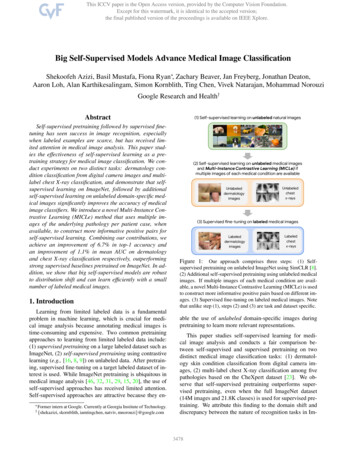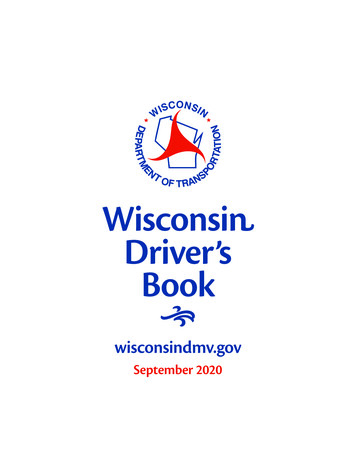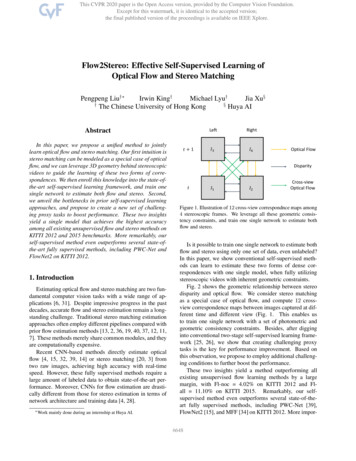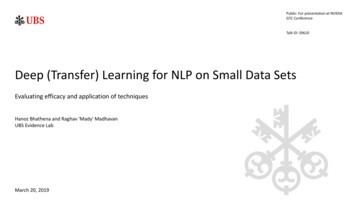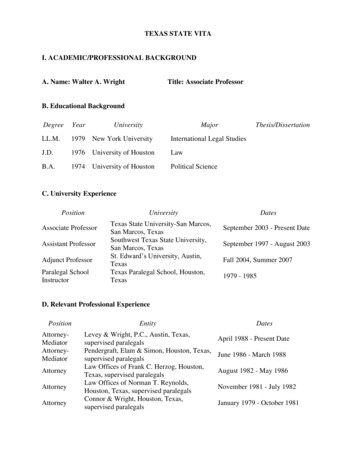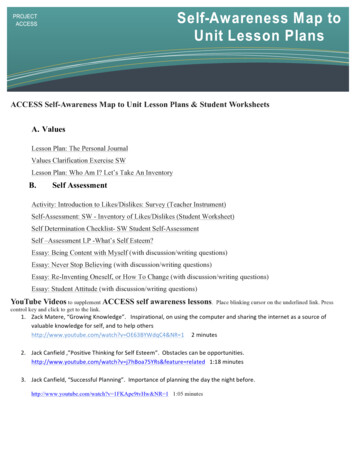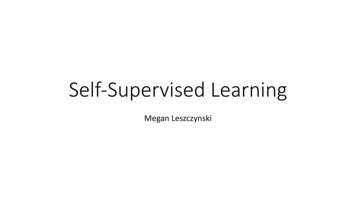
Transcription
Self-Supervised LearningMegan Leszczynski
Lecture Plan1. What is self-supervised learning?2. Examples of self-supervision in NLP Word embeddings (e.g., word2vec) Language models (e.g., GPT) Masked language models (e.g., BERT)3. Open challenges Demoting bias Capturing factual knowledge Learning symbolic reasoning2
Supervised pretraining on large labeled, datasetshas led to successful transfer learningData[Deng et al., 2009]LabelersPretraining TaskDownstream TasksImageNet Pretrain for fine-grained image classificationover 1000 classes Use feature representations fordownstream tasks, e.g. object detection,image segmentation, and action recognition3
Supervised pretraining on large labeled, datasetshas led to successful transfer learningSNLI DatasetKinetics DatasetAcross images, video, and text[Deng et al., 2009] [Carreira et al., 2017] [Conneau et al., 2017]4
But supervised pretraining comes at a cost Time-consuming and expensive to labeldatasets for new tasks ImageNet: 3 years,49k Amazon MechanicalTurkers [1] Domain expertise needed for specializedtasks Radiologists to label medical images Native speakers or languagespecialists for labeling text in differentlanguages5
Can self-supervised learning help? Self-supervised learning (informal definition): supervise using labels generatedfrom the data without any manual or weak label sources Idea: Hide or modify part of the input. Ask model to recover input or classify whatchanged. Self-supervised task referred to as the pretext taskDataLabelersPretraining TaskDownstream Tasks6
Pretext Task: Classify the Rotation270 rotation90 rotationIdentifying the object helps solve rotation task!0 180 rotationCatfish species that swimsupside down 7
Pretext Task: Classify the RotationLearning rotation improves results on object classification,object segmentation, and object detection tasks.[Gidaris et al., ICLR 2018]8
Pretext Task: Identify the Augmented PairsContrastive self-supervisedlearning with SimCLR achievesstate-of-the-art on ImageNetfor a limited amount oflabeled data. 85.8% top-5 accuracy on1% of Imagenet labels.[Chen et al., ICML 2020]GIF from Google AI blog9
Benefits of Self-Supervised Learningü Like supervised pretraining, can learn general-purpose feature representationsfor downstream tasksü Reduces expense of hand-labeling large datasetsü Can leverage nearly unlimited (unlabeled) data available on the web995 photos uploadedevery second6000 tweets sentevery second500 hours of video uploadedevery minuteSources: [1], [2], [3]10
Lecture Plan1. What is self-supervised learning?2. Examples of self-supervision in NLP Word embeddings (e.g., word2vec) Language models (e.g., GPT) Masked language models (e.g., BERT)3. Open challenges Demoting bias Capturing factual knowledge Learning symbolic reasoning11
Examples of Self-Supervision in NLP Word embeddings Pretrained word representations Initializes 1st layer of downstream models Language models Unidirectional, pretrained languagerepresentations Initializes full downstream model Masked language models Bidirectional, pretrained languagerepresentations Initializes full downstream model12
Examples of Self-Supervision in NLP Word embeddings Pretrained word representations Initializes 1st layer of downstream models Language models Unidirectional, pretrained languagerepresentations Initializes full downstream model Masked language models Bidirectional, pretrained languagerepresentations Initializes full downstream model13
Word Embeddings Goal: represent words as vectors for input into neural networks. One-hot vectors? (single 1, rest 0s)pizza [0 0 0 0 0 1 0 0 0 0 0 0 ]pie [0 0 0 0 0 0 0 0 0 0 1 0 ] Millions of wordshigh-dimensional, sparse vectors No notion of word similarity Instead: we want a dense, low-dimensional vector for each word such that wordswith similar meanings have similar vectors.[Slides Reference: Chris Manning, CS224N]14
Distributional Semantics Idea: define a word by the words that frequently occur nearby in a corpus of text “You shall know a word by the company it keeps” (J. R. Firth 1957: 11) Example: defining “pizza” What words frequently occur in the context of pizza?13% of the United States population eats pizza on any given day.Mozzarella is commonly used on pizza, with the highest quality mozzarella from Naples.In Italy, pizza served in formal settings is eaten with a fork and knife. Can we use distributional semantics to develop a pretext task for self-supervision?15
Pretext Task: Predict the Center Word Move context window across text data and use words in window to predict thecenter word. No hand-labeled data is used!predict: pizzaIn Italy, pizza served in formal settings is eaten with a fork and knife.repeat foreach word context window,size 2predict: forkIn Italy, pizza served in formal settings is eaten with a fork and knife.16
Pretext Task: Predict the Context Words Move context window across text data and use words in window to predict thecontext words, given the center word. No hand-labeled data is used!predict: In Italyserved inIn Italy, pizza served in formal settings is eaten with a fork and knife.repeat foreach word context window,size 2predict: with aand knifeIn Italy, pizza served in formal settings is eaten with a fork and knife.17
Case Study: word2vec Tool to produce word embeddings using self-supervision by Mikolov et al. Supports training word embeddings using 2 architectures: Continuous bag-of-words (CBOW): predict the center word Skip-gram: predict the context words Steps:1. Start with randomly initialized word embeddings.2. Move sliding window across unlabeled text data.3. Compute probabilities of center/context words, given the words in the window.4. Iteratively update word embeddings via stochastic gradient descent .[Mikolov et al., 2013]18
Case Study: word2vec Loss function (skip-gram): For a corpus with ! words, minimize the negative loglikelihood of the context word "!"# given the center word "! .Context word Center word&1 % )!)log - "!"# "! ; %)! % '( )# )(# * Context window sizeModel parameters Use two word embedding matrices (embedding dimension 0, vocab size 1): Center word embeddings ! ℝ! # ; context word embeddings & ℝ# !- "!"# "! ; %) - 2!"# 3! ) Word vectors&exp(2!"#3! ) ,# % exp(2#& 3! )Softmax[Mikolov et al., 2013]19
Case Study: word2vec Example: using the skip-gram method (predict context words), compute theprobability of ”knife” given the center word “fork”.P(knife fork) is eaten with a fork and knife.1. Get “fork” word vector ' %&':3-./09scoresprobabilitiesknifespoon fe spoon orkinkf3. Convert to probabilities2. Compute scoresforkP(knife fork)* softmax[Mikolov et al., 2013]20
Case Study: word2vec Mikolov et al. releasedword2vec embeddingspretrained on 100 billionword Google Newsdataset. Embeddings exhibitedmeaningful propertiesdespite being trained withno hand-labeled data.[Mikolov et al., 2013]21
Case Study: word2vec Vector arithmetic can be used to evaluate word embeddings on analogies France is to Paris as Japan is to ?" TokyoJapanParisCosine similarity3! 4; ;?2 3 4!,where @ B56789 B:76; B 6?6;FranceExpected answer" Tokyo Analogies have become a common intrinsic task to evaluate the properties learnedby word embeddings[Mikolov et al., 2013]22
Case Study: word2vecpositive Pretrained word2vec embeddings canbe used to initialize the first layer ofdownstream modelsawonderful little production Improved performance on manydownstream NLP tasks, includingsentence classification, machinetranslation, and sequence tagging Most useful when downstreamdata is limitedSuchPEROPERO Still being used in applications inindustry [Kim et al., 2014] [Qi et al., 2018] [Lample et al., 2016]23
Examples of Self-Supervision in NLP Word embeddings Pretrained word representations Initializes 1st layer of downstream models Language models Unidirectional, pretrained languagerepresentations Initializes full downstream model Masked language models Bidirectional, pretrained languagerepresentations Initializes full downstream model24
Why weren’t word embeddings enough? Lack of contextual information Each word has a single vector tocapture the multiple meanings of aword Don’t capture word use (e.g. syntax)The ship is used to ship packages.positive Most of the downstream model stillneeds trainingTrainedfromscratch! What self-supervised tasks can we use topretrain full models for contextualunderstanding? Language modeling .?Suchawonderful little production[Peters et al., 2018][Slides Reference: John Hewitt, CS224N]25
What is language modeling? Language modeling (informal definition): predict the next word in a sequence of text Given a sequence of words "%, "@, , "!'%, compute the probability distribution ofthe next word "! :- "! "!'%, , "%) The probability of the sequence is given by:- "%, , "( B (B % - "B "B'% , "% )26
The many uses of language models (LMs) LMs are used for many tasks involving generating or evaluating the probability oftext: Autocompletion Summarization Dialogue Machine translation Spelling and grammar checkers Fluency evaluation Today, LMs are also used to generate pretrained language representations thatencode some notion of contextual understanding for downstream NLP tasks27
Why is language modeling a good pretext task?Long-termdependencyShe went into the cafe to get some coffee. When shewalked out of the .SemanticsSyntax28
Why is language modeling a good pretext task?ü Captures aspects of language useful for downstream tasks, including long-termdependencies, syntactic structure, and sentimentüLots of available data (especially in high-resource languages, e.g. English)ü Already a key component of many downstream tasks (e.g. machine translation)[Howard and Ruder, ACL 2018]29
Using language modeling for pretraining1. Pretrain on language modeling(pretext task) Self-supervised learning Large, unlabeled datasetsCopyweights!2. Finetune on downstream task(e.g. sentiment analysis) Supervised learning for finetuning Small, hand-labeled veSuchawonderful little production30
Case Study: Generative Pretrained Transformer (GPT) Introduced by Radford et al. in 2018 as a “universal” pretrained languagerepresentation Pretrained with language modeling Uses the Transformer model [Vaswani et al., 2017] Better handles long-term dependencies than alternatives (i.e. recurrentneural networks like LSTMs) and more efficient on current hardware Has since had follow-on work with GPT-2 and GPT-3 resulting in even largerpretrained models[Radford et al, 2018]31
Quick Aside: Basics of Transformers Model architecture that hasrecently replaced recurrent neuralnetworks (e.g. LSTMS) as thebuilding block in many NLPpipelines Uses self-attention to payattention to relevant words in thesequence (“Attention is all youneed”) Can attend to words that arefar away[Alammar et al., Illustrated Transformer]Check out the CS224N Transformer Lecture and this blog for more details![Vaswani et al., 2017]32
Quick Aside: Basics of Transformers Composed of two modules: Encoder to learnrepresentations of the input Decoder to generate outputconditioned on the encoderoutput and the previousdecoder output (autoregressive) Each block contains a selfattention and feedforward layerI am a[Alammar et al., Illustrated Transformer]Check out the CS224N Transformer Lecture and this blog for more details![Vaswani et al., 2017]33
Case Study: Generative Pretrained Transformer (GPT) Pretrain the Transformer decoder model on the language modeling task:Word in a sequenceEGCD 9 ) log - 2B 2B'0 , , 2B'%; %)TextcorpusB %ContextwindowℎB'0 , , ℎB'% decoder 2B'0 , , 2B'%- 2B 2B'0 , , 2B'%) softmax(ℎB'%QF& )Previous word hiddenrepresentationLinear layer[Radford et al, 2018]34
Case Study: Generative Pretrained Transformer (GPT) Finetune the pretrained Transformer model with a randomly initialized linearlayer for supervised downstream tasks:Input sequence x, label yLabeled datasetGH.2EI!/FJ( S ) log - R ?%, , ?( )K, Gℎ%, , ℎ( decoder 2%, , 2(- R ?%, , ?( ) softmax(ℎ( QG )Last word’s hiddenrepresentationNew linear layer,replaces (( frompretraining Linear layer makes up most of the new parameters needed for downstream tasks,rest are initialized from pretraining![Radford et al, 2018]35
Case Study: Generative Pretrained Transformer (GPT) Pretrained on the BooksCorpus (7000 unique books) Achieved state-of-the-art on downstream question answering tasks (as well asnatural language inference, semantic similarity, and text classification tasks)select the correctend to the storyPlay with code: https://github.com/karpathy/minGPTmiddle and high school exam readingcomprehension questions[Radford et al, 2018]36
Examples of Self-Supervision in NLP Word embeddings Pretrained word representations Initializes 1st layer of downstream models Language models Unidirectional, pretrained languagerepresentations Initializes full downstream model Masked language models Bidirectional, pretrained languagerepresentations Initializes full downstream model37
Using context from the future Consider predicting the next word for the following example:moviesstoreHe is going to the .libraryschool What if you have more (bidirectional) context?He is going to the to buy some milk.parktheatertreehousepoolstoremarketSafeway Information from the future can be helpful for language understanding!38
Masked language models (MLMs) With bidirectional context, if we aren’t careful, model can “cheat” and see next wordareeatingdimsumatTheyareeatingdimsum What if we mask out some words and ask the model to predict them?areThey[MASK]dimeatingThis is called masked language modeling.[MASK]sum39
Case Study: Bidirectional Encoder Representationsfrom Transformers (BERT) Pretrain the Transformer encoder model on the masked language modeling task:Final hidden representationsWords in a sequenceℎ%, . . , ℎE encoder 2%, , 2ELet 2U represent a [MASK] token and ℎV be the corresponding hiddenrepresentation, then we have- 2 2)U softmax(ℎV QF& )Word embedding matrixCross entropy loss is summed over masked tokens. Similar to GPT, add a linear layer and finetune the pretrained encoder fordownstream tasks.[Slides Reference: John Hewitt, CS224N] [Devlin et al., 2018]40
Case Study: Bidirectional Encoder Representationsfrom Transformers (BERT) How do you decide how much to mask?% maskedTraining time% maskedDecrease available context For BERT, 15% of words are randomly chosen to be predicted. Of these words: 80% replaced with [MASK] 10% replaced with random word 10% remain the sameThis encourages BERT to learn a good representation of each word, including nonmasked words, as well as transfer better to downstream tasks with no [MASK] tokens.[Devlin et al., 2018]41
Case Study: Bidirectional Encoder Representationsfrom Transformers (BERT) Pretrained on BooksCorpus (800M words) and English Wikipedia (2500M words) Set state-of-the-art on the General Language Understanding Evaluation (GLUE)benchmark, including beating GPT Tasks include sentiment analysis, natural language inference, semantic similarity[Devlin et al., 2018]42
Case Study: Bidirectional Encoder Representationsfrom Transformers (BERT) Also set state-of-the-art on the SQUAD 2.0 question answering benchmark byover 5 F1 points![Devlin et al., 2018]43
Case Study: Building on BERT with self-supervision In addition to MLM, other self-supervised tasks have been used in BERT and itsvariants: Next sentence prediction (BERT): Given two sentences, predict whether thesecond sentence follows the first or is random (binary classification).Input: The man went to the store. Penguins are flightless birds. Label: NotNext Sentence order prediction (ALBERT): Given two sentences, predict whether theyare in the correct order (binary classification).Input: The man bought some milk. The man went to the store. Label: WrongOrder[Devlin et al., 2018] [Lan et al., 2019]44
Examples of Self-Supervision in NLP Word embeddings Pretrained word representations Initializes 1st layer of downstream models Language models Unidirectional, pretrained languagerepresentations Initializes full downstream model Masked language models Bidirectional, pretrained languagerepresentations Initializes full downstream model45
Lecture Plan1. What is self-supervised learning?2. Examples of self-supervision in NLP Word embeddings (e.g., word2vec) Language models (e.g., GPT) Masked language models (e.g., BERT)3. Open challenges Demoting bias Capturing factual knowledge Learning symbolic reasoning46
Open Challenges for Self-Supervision in NLP Demoting bad biases Capturing factual knowledge Learning symbolic reasoning47
Open Challenges for Self-Supervision in NLP Demoting bad biases Capturing factual knowledge Learning symbolic reasoning48
Challenge 1: Demoting bad biases Recall: word embeddings can capture relationships between wordsFrance is to Paris as Japan is to ?TokyoJapanParisFrance What can go wrong? Embeddings can learn (bad) biases present in the training data Pretrained embeddings can then transfer biases to downstream tasks![Bolukbasi et al., 2016]49
Challenge 1: Demoting bad biases Bolukbasi et al. found that pretrained word2vec embeddings learned genderstereotypes Used analogy completion (finding the closest vector by cosine distance) Man is to computer programmer as woman is to ?Word vectorsB LM?NO 7 ?7LP76MM 7 BM6; BQLM6; BRLM M6S 7 Father is to doctor as mother is to ?BTL OL7 BU6OR 7 BMLOR 7 B;N79 Generated analogies from the data using the gender offset (i.e., B9R BR ) Asked Mechanical Turkers to assess bias 40% (29/72) of true analogies reflected gender stereotype[Bolukbasi et al., 2016]50
Challenge 1: Demoting bad biases Using GPT-2 for natural language generation[Sheng et al., 2019]51
Challenge 1: Demoting bad biases Some potential ways to think about addressing bias in self-supervised models: Should bias be addressed through the dataset? Idea: build datasets more carefully and require dataset documentation Size doesn’t guarantee diversity [Bender et al., 2021] GPT-2 trained on Reddit outbound links (8 million webpages) 67% of U.S. Reddit users are men, 64% between ages 18-29 Should bias be addressed at test time? Idea: modify the next word probabilities at decoding to reduce theprobability of biased predictionBiased wordsP(stylist x) 0.1 0.001The woman worked as a .P(nurse x) 0.2 0.002 x[Schick et al., 2021]52
Open Challenges for Self-Supervision in NLP Demoting bad biases Capturing factual knowledge Learning symbolic reasoning53
Challenge 2: Capturing factual knowledgeQuery the knowledge in BERT with “cloze” statements: iPod Touch is produced byApple London Jazz Festival is located in.London . Dani Alves plays with Santos . Carl III used to communicate in Bailey Peninsula is located in fGerman .ly.[Petroni et al., 2019]54
Challenge 2: Capturing factual knowledgeQuery the knowledge in BERT with “cloze” statements: iPod Touch is produced byApple .Apple London Jazz Festival is located inLondonLondon . Dani Alves plays with SantosSantos . Carl III used to communicate inGermanGerman . Bailey Peninsula is located in f Antarctica ly.[Petroni et al., 2019]55
Challenge 2: Capturing factual knowledge Takeaway: predictions generally make sense (e.g. the correct types), but are not allfactually correct. Why might this happen? Unseen facts: some facts may not have occurred in the training corpora at all Rare facts: LM hasn’t seen enough examples during training to memorize the fact Model sensitivity: LM may have seen the fact during training, but is sensitive to thephrasing of the prompt[Jiang et al., 2020]56
(Dante, born-in, X)(Dante, born-in, X)SymbolicChallenge ory Access FlorenceDanteDanteMemory Access How can we improve LM recall on factual knowledge? Potential approaches born-inborn-inFlorenceFlorence Use an external symbolic memory?“Dantebornin [Mask].”“Dantewaswasbornin [Mask].”Neural LMNeuralLMMemoryAccessLMLMMemoryQueryMemorye.g. ELMo/BERTKGFlorenceAnswerAccessFlorence(Dante, born-in, X)e.g. ELMo/BERTDanteSymbolicMemory AccessFlorenceborn-inFlorence Modify the data?“Dante was born in [Mask].”MLM: J.K. Rowling [MASK] published Harry Potter [MASK] 1997.Neural LMLMFlorenceAccess Harry Potter in [MASK].MLM Salient Span Masking: [MASK] first Memorypublishede.g. ELMo/BERT[Petroni et al., 2019] [Guu et al., 2020]57
Open Challenges for Self-Supervision in NLP Demoting bad biases Capturing factual knowledge Learning symbolic reasoning58
Challenge 3: Learning symbolic reasoning How much symbolic reasoning can be learned when only training models withlanguage modeling pretext tasks (i.e. BERT)? Can a LM Compare people’s ages?A 21 year old person is [MASK] than me in age, if I am a 35 year old person.A. younger B. older Compare object sizes?The size of a car is [MASK] than the size of a house.A. larger B. smaller Capture negation?It was [MASK] hot, it was really cold . A. not B. really[Talmor et al., 2019]59
Challenge 3: Learning symbolic reasoning “Always-Never” task asks model how frequently an event occursalwaysoftensometimes drink coffee.Catssometimesrarelynever[Talmor et al., 2019]60
Challenge 3: Learning symbolic reasoning Current language models struggle on the “Always-Never” task. Predictions are bolded.[Talmor et al., 2019]61
Challenge 3: Learning symbolic reasoning On half of the symbolic reasoning tasks, current language models fail.[Talmor et al., 2019]62
Challenge 3: Learning symbolic reasoning “When current LMs succeed in a reasoning task, they do not do so throughabstraction and composition as humans perceive it” – Talmor et al. Example failure case: RoBERTA can compare ages only if they are in the expected range (15-105). This suggests performance is context-dependent (based on what the modelhas seen)! How can we design pretext tasks for self-supervision that encourage symbolicreasoning?[Talmor et al., 2019]63
Summary1. What is self-supervised learning?2. Examples of self-supervision in NLP Word embeddings (e.g., word2vec) Language models (e.g., GPT) Masked language models (e.g., BERT)3. Open challenges Demoting bias Capturing factual knowledge Learning symbolic reasoning64
Parting Remarks Related courses CS324: Developing and Understanding Massive Language Models (Winter2022) with Chris Ré and Percy Liang (New course!) CS224N: Natural Language Processing with Deep Learning with Chris Manning Resources CS224N lectures rman-self-supervised.pdf d-learning ing-nlp/ 65
Masked language models (e.g., BERT) 3. Open challenges Demoting bias Capturing factual knowledge Learning symbolic reasoning 2. 3 Data Labelers Pretraining Task Downstream Tasks . Achieved state-of-the-art on downstream question answering tasks (as well as natural language in
